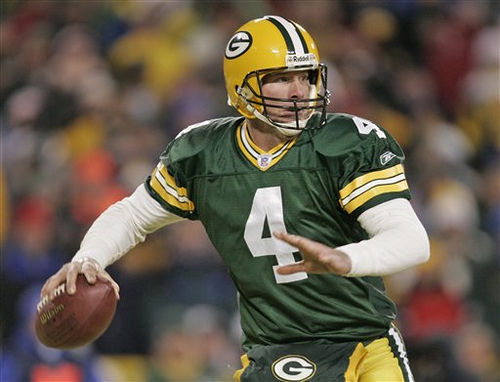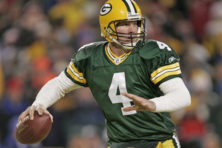Brett Favre Meant More to the Packers than Most Remember
- Share
- Tweet
- Pin
- Share

In Wisconsin, we’re spoiled by greatness. As Packers fans bask in the joy of watching Aaron Rodgers at quarterback for the ninth season, and our 25th straight season with a Hall of Fame quarterback under center, it’s easy to forget just how far the franchise has come.
If you’re a sports fan under the age of 35, you likely know the team only as a contender, as the subject of magazine covers, headlines, and prime time football games. Today, the Packers are a model franchise, not just in football, but in all of sports. They are what other organizations aspire to be for just a season, let alone a generation.
If you’re a little older, like those Packers fans who grew up in the doldrums of the 1970s and 1980s, it’s still odd to see the Packers near the top of the power rankings each year, cemented among the best. You still view your team, and yourself, as the underdog. To understand that and just how much Brett Favre meant to the Green Bay Packers organization, you have to go back to 1991, the last season before Favre.
That was a time when it was big news if the Packers were even mentioned in Sports Illustrated, or earned a paragraph or two in USA Today. That’s not news as in “my friends mentioned it” news, but as in, it actually made the nightly news in Green Bay. There were news stories about the Packers making the news.
Being a Packers fan meant justifying it to the outside world, and even to some of your neighbors. When that season started, it was still common to look around classrooms in Northeast Wisconsin and find a fair amount of Cowboys, Bears, and 49ers fans. To be a Packers fan you had to be dedicated, you needed a strong stomach, you needed to be able to take it. You were to the 1980s what the fans of the Cleveland Browns are today – the fan that other fans felt sorry for.
Favre’s first year as the Packers starter ended with the Packers going 9 – 7 and missing the playoffs, marking the 23rd straight non-strike season in which the Packers season ended with the last regular season game. But there was hope in Green Bay, an excitement built in part on Sterling Sharpe, but mostly on Favre. A look at the rest of that roster makes you wonder how they won nine games.
Favre though, had made an impression on the second most important Packer of the last 50 years, Reggie White. That offseason, in the first year of free agency, White was the big prize that every contender was after. Sports Illustrated put White on its cover in the middle of a half dozen jerseys of teams thought to be in contention for his services.
A Green Bay Packers jersey was not among them.
But when the dust settled, White was a Packer, thanks to millions of dollars and Favre, whom White believed was a quarterback capable of winning a Super Bowl. With that signing, the Packers became contenders, and a bonafide franchise in the eyes of the rest of the NFL. Half of the roster was still a mess – Darrell Thompson, Roland Mitchell, Matt Brock, John Jurkovic, and the ghost of Mark Clayton all filled starting positions – but Mike Holmgren and Ray Rhodes devised enough ways to use the little talent on hand to eke out a playoff spot.
Though the team improved steadily, it was still a shock when Sports Illustrated’s season preview issue arrived in August of 1996. (For the youngsters reading, there was a time when this a huge deal, an issue hotly anticipated with previews about every team. This was normally the first and last mention of the Packers in Sports Illustrated each year).
Favre, White, and wide receiver Robert Brooks were on the cover, and the Packers were picked to go to the Super Bowl. Sure, we cheeseheads were talking Super Bowl, but we wore green and gold colored lenses. To see Peter King and the writers at Sports Illustrated picking the Packers was validation that we weren’t crazy.
They fulfilled that promise, of course, ending a 29-year Super Bowl drought by steamrolling the league for most of the season. The entire year was a celebration, as the Packers fan base turned out in droves nationwide, desperate to make sure they soaked in every moment of attention focused on their team. Success wasn’t assumed then, and it wasn’t taken for granted. The league wasn’t designed for cities like Green Bay to stay on top of the mountain.
That team is remembered as a juggernaut, but a closer look at the offensive talent makes you realize just how great Favre was, how much he carried that offense. The team’s top wide receiver, Robert Brooks, destroyed his knee in week 7 and was lost for the season. The team’s number two receiver, Antonio Freeman, went down in week 9 with a broken arm, missing five weeks.
The team somehow went 3 – 2 (losing to fellow Super Bowl contenders Kansas City and Dallas on the road) with such legends as Terry Mickens, Derrick Mayes, and career backup Don Beebe at receiver before Freeman returned in a cast and Andre Rison was picked up off waivers.
That Packers offense had no other hall of famers, and only one player who made even three Pro Bowls as a Packer, yet Favre earned his second straight MVP regardless, throwing 39 touchdown passes, the third highest ever at the time, in an era when the 30 touchdown mark had been surpassed just 11 times in the previous 12 seasons, two of those by Favre (consider that 11 quarterbacks threw for 31 or more touchdowns in the 2015 season alone).
The biggest star in football, the one other stars stopped to watch, wore a Green Bay uniform and made it cool.
Who knows what happens if Favre never plays for Green Bay. It’s hard to imagine Reggie White signing with them, or the team returning to the Super Bowl in 1996. And absent that, it’s unclear that the pivotal referendum to expand and refurbish Lambeau Field in 2000 ever passes? (It sounds absurd to consider, but after the team’s most successful stretch since Lombardi prowled the sidelines, the referendum passed with just 53% in favor. Would it have succeeded after another decade of losing?).
When careers are tallied, you’d be hard-pressed to place Favre over Tom Brady or Joe Montana, but beyond those two, you can mix and match with the likes of Johnny Unitas, Bart Starr, Peyton Manning, Otto Graham and Drew Brees (no, not John Elway or Marino. The stats, the numbers, and the tape don’t lie, and while both were great, they belong in the next tier). Another great year or two, and Aaron Rodgers is in that group.
But none had such an indelible impact or could be credibly argued to have saved a franchise. Most importantly, none were more fun to watch than Brett Lorenzo Favre, and it’s not even close. In his most difficult season last year, Rodgers began to tally moments, those career-defining plays that people point to decades later. Montana had a handful, Brady as well. Manning was a robot, so much so that no single play stands out from the rest as remarkable. Go ahead, try to think of the defining Manning play. You can’t.
But Favre provided dozens of such moments, but none of those singular snippets of tape are as important as the whole, a career that reshaped a franchise.
Now imagine it’s the year 2041, and the Cleveland Browns are Super Bowl Favorites again, in the midst of a 25-year run of dominance, and you look back to 2016, the year Robert Griffin the III sparked the franchise’s return to glory.
It’s unbelievable right? That same tail about the Packers and Brett Favre sounded even crazier in August of 1992.

